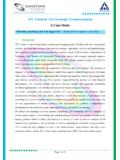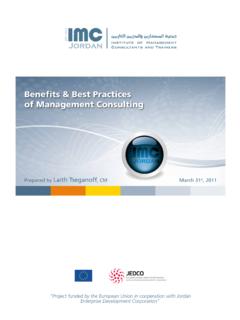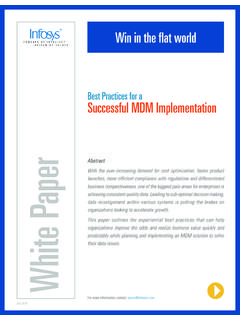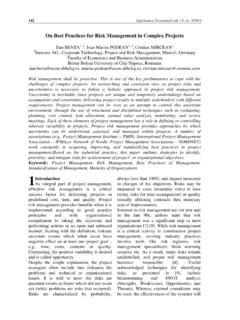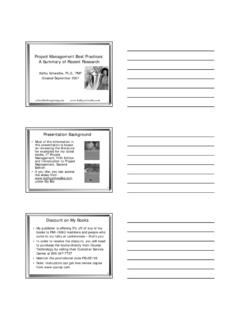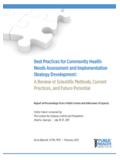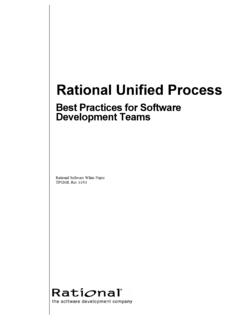Transcription of Execution Excellence for SATTVA - Final - …
1 Samatvam Academy, M-1/31, DLF City Phase II, Gurgaon 122 002, India. Execution Excellence by Dilbag Singh and Dr. Sunil Maheshwari Execution lies at the heart of all of human activity - commercial or non-commercial. The literal meaning of the term Execution is to bring to a successful conclusion . Excellence denotes the state or quality of being exceptionally good or extremely meritorious, and implies perpetual efforts to advance the frontiers of accomplishment. Therefore, Execution Excellence may be defined as a phenomenon of bringing an act to successful accomplishment, and surpass previous levels of in doing so.
2 Thus, Execution Excellence involves acting in a manner so as to overachieve the objectives set out for an individual / team / organization. According to a study by Neilson, Martin & Powers (2008) that involved 125,000 people (about 25% of whom came from executive ranks) representing more than 1,000 companies, government agencies, and not-for-profit organizations in over 50 countries, employees at three out of every five companies rated their organization as being weak at Execution . When asked if they agreed with the statement Important strategic and operational decisions are quickly translated into action, the majority of employees answered in the negative.
3 Each organization has the opportunity to revolutionize operations in order to deliver increased efficiency, coupled with enhanced effectiveness. Such a revolution calls for synchronizing talented people with robust processes to achieve Execution Excellence . Superior on-the-ground Execution results from a systematic process of rigorously questioning methods and techniques, following through and ensuring accountability for the human and operational processes in an organization (Bossidy & Charan, 2002). Excellence in Execution is achieved by deployment of a three-stage process sequence that helps bring about the desired alignment of people and processes to achieve the desired level of output.
4 The three stages are: 1. Organize: To arrange or systematize, to provide it with everything useful or it s functioning raw material, tools, capital and people. 2. Mobilize: To innovatively marshal limited resources and resolve any issue/problem arising in the path. 3. Harmonize: To complement and leveraging the strengths of every team member in a coherent manner. To create harmonious inter-relationships among the various stakeholders. Samatvam Academy, M-1/31, DLF City Phase II, Gurgaon 122 002, India. 1. The Organize Phase The dictionary meaning of organize is to arrange or systematize.
5 It is the process of bringing resources together for achievement of desired goals. According to Henry Fayol, to organize is to provide it with everything useful or it s functioning raw material, tools, capital and people (Fayol, 1949). The Organize stage provides directions for achieving the objectives set out during strategic plans or customer expectation. Identifying these objectives or customer expectations, preparing a plan to achieve them and constant monitoring, form the two pillars of organize phase. Planning and Monitoring are very closely related functions.
6 The scope of their activities is actually overlapping. Without the foundation provided by planning, the monitoring of activities becomes baseless. On the other hand, planning can become a meaningless and inert exercise without any monitoring of activities relating to the implementation of plans. Therefore, planning and monitoring reinforce each other. Planning Planning refers to anticipating the future conditions and choosing from among the alternative future courses of action. It involves creation of a plan aimed at achieving the stated objectives.
7 The planning process generally includes the following core activities (Kuttyta, 2012): 1. Forecasting: It is one of the essential steps in planning. It requires is looking ahead to anticipate the opportunity, problems and conditions in a future period of time. The success of the plan depends on Samatvam Academy, M-1/31, DLF City Phase II, Gurgaon 122 002, India. the getting the forecasts right. The main objective of this step is to minimize uncertainty and to identify and evaluate risk. 2. Establishing objectives means setting the end results to be accomplished by directing efforts.
8 The objectives must be clear, specific and informative. In order to set realistic objectives, planning team must be fully aware of the opportunities and problems that the team is likely to face. 3. Programming is establishing the activities and actions to be followed in the attainment of the objectives. This stage involves identifying and listing down all the actions that are to be completed in order to achieve the outlined objectives. All major activities are further broken down into sub-activities during this process. 4. Scheduling is deciding on time sequence for program steps with their respective start and finish times/dates.
9 Careful consideration is to be given to the relationships between the activities at this stage. 5. Budgeting is allocation of resources to minimize costs. The resource allocation is done taking into consideration both the resource availability and the project time. 6. Establishing procedures means developing and applying standardized methods of performing a specific work. Good procedures are action oriented. They clearly outline the steps to be taken and their order. Well-written procedures are typically solid, precise, factual, short, and to the point.
10 The output of the planning process is a plan. A plan has a time frame, whether it is explicit or implied. It is a commitment to action and commitment of resources. It is also a package of decisions on intended efforts to achieve some results. It is a relatively static picture or blue print of action, which are partly a means of mechanism of planning and partly an end product of the planning process (Tulsian & Pandey, 2002). Monitoring Monitoring implies regular measurement of accomplishment against the standards and correction of deviation if any to ensure achievement of goals.
